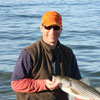Check Your Fly Fishing Gear Knowledge
By Tom Keer
May 25, 2016
Terminology can be confusing for fly fishing beginners. Luckily, learning to fly fish isn't hard, and understanding these five common terms will make it easier.
Confused about some fly fishing gear terminology? So are many folks learning the sport. Here are 5 quick answers to commonly asked questions.
What do dry fly, wet fly, streamer, and nymph mean? Types of fishing flies match the stream-born meals. Dry flies are fished on the surface and imitate the adult insect drying its wings. Wet flies are fished sub-surface and resemble the insect traveling from the streambed to the surface. Streamers mimic baitfish while nymphs are immature insects.
Rod Action: Fast, Medium, Slow? Fly rods are described by fast, medium, and slow which refers to how much of the rod bends during the cast. A fast action flexes in the tip, a medium action bends through the middle of the rod, and a slow action bends all the way to the butt. Stiffer rods are better for long casts while slower rods excel in close.
What the heck is an X size? A fly fishing leader has three parts: the butt, the graduation, and the tippet. The butt is the thickest section, the graduation is the part that gets progressively thinner until it finishes off in the thinnest and final 18 inches that connects with the fly. X refers to the tippet thickness, with 0X being about 15 pound test, 1X is about 13 pounds, 2X is 11 pounds and so forth to 8X. To figure out what X size tippet to use, divide your fly size by 4 and you're about right. A size 16 fly (divided by 4) gives you a 4X tippet.
What is a single-action fly reel? For every full turn on the crank, the fly spool spins one full turn. Spinning reels are multipliers, and for every full turn on the crank the spool spins several times.
What is drag and why does it matter? Drag is when your fly moves at a speed faster than a natural insect. It happens in rivers and streams that have different speeds of current. If your fly lands in slow water and your line lands in fast water, the line will pull your fly faster than normal. River fish like trout eat flies that resemble what is in the river, and if natural insects are drifting gently down the river and yours goes zipping by, they're less likely to hit it. Drag isn't as much of an issue in ponds, lakes, or in the saltwater.
There's more to absorb about fly fishing gear, but the best way to learn is to get your fishing license and get on the water.
What do dry fly, wet fly, streamer, and nymph mean? Types of fishing flies match the stream-born meals. Dry flies are fished on the surface and imitate the adult insect drying its wings. Wet flies are fished sub-surface and resemble the insect traveling from the streambed to the surface. Streamers mimic baitfish while nymphs are immature insects.
Rod Action: Fast, Medium, Slow? Fly rods are described by fast, medium, and slow which refers to how much of the rod bends during the cast. A fast action flexes in the tip, a medium action bends through the middle of the rod, and a slow action bends all the way to the butt. Stiffer rods are better for long casts while slower rods excel in close.
What the heck is an X size? A fly fishing leader has three parts: the butt, the graduation, and the tippet. The butt is the thickest section, the graduation is the part that gets progressively thinner until it finishes off in the thinnest and final 18 inches that connects with the fly. X refers to the tippet thickness, with 0X being about 15 pound test, 1X is about 13 pounds, 2X is 11 pounds and so forth to 8X. To figure out what X size tippet to use, divide your fly size by 4 and you're about right. A size 16 fly (divided by 4) gives you a 4X tippet.
What is a single-action fly reel? For every full turn on the crank, the fly spool spins one full turn. Spinning reels are multipliers, and for every full turn on the crank the spool spins several times.
What is drag and why does it matter? Drag is when your fly moves at a speed faster than a natural insect. It happens in rivers and streams that have different speeds of current. If your fly lands in slow water and your line lands in fast water, the line will pull your fly faster than normal. River fish like trout eat flies that resemble what is in the river, and if natural insects are drifting gently down the river and yours goes zipping by, they're less likely to hit it. Drag isn't as much of an issue in ponds, lakes, or in the saltwater.
There's more to absorb about fly fishing gear, but the best way to learn is to get your fishing license and get on the water.
Popular Posts









